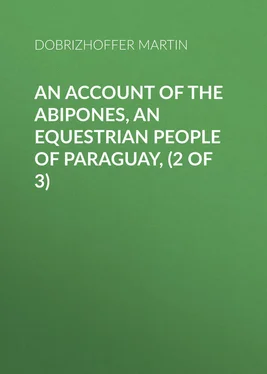Martin Dobrizhoffer - An Account of the Abipones, an Equestrian People of Paraguay, (2 of 3)
Здесь есть возможность читать онлайн «Martin Dobrizhoffer - An Account of the Abipones, an Equestrian People of Paraguay, (2 of 3)» — ознакомительный отрывок электронной книги совершенно бесплатно, а после прочтения отрывка купить полную версию. В некоторых случаях можно слушать аудио, скачать через торрент в формате fb2 и присутствует краткое содержание. Жанр: foreign_antique, foreign_prose, на английском языке. Описание произведения, (предисловие) а так же отзывы посетителей доступны на портале библиотеки ЛибКат.
- Название:An Account of the Abipones, an Equestrian People of Paraguay, (2 of 3)
- Автор:
- Жанр:
- Год:неизвестен
- ISBN:нет данных
- Рейтинг книги:3 / 5. Голосов: 1
-
Избранное:Добавить в избранное
- Отзывы:
-
Ваша оценка:
- 60
- 1
- 2
- 3
- 4
- 5
An Account of the Abipones, an Equestrian People of Paraguay, (2 of 3): краткое содержание, описание и аннотация
Предлагаем к чтению аннотацию, описание, краткое содержание или предисловие (зависит от того, что написал сам автор книги «An Account of the Abipones, an Equestrian People of Paraguay, (2 of 3)»). Если вы не нашли необходимую информацию о книге — напишите в комментариях, мы постараемся отыскать её.
An Account of the Abipones, an Equestrian People of Paraguay, (2 of 3) — читать онлайн ознакомительный отрывок
Ниже представлен текст книги, разбитый по страницам. Система сохранения места последней прочитанной страницы, позволяет с удобством читать онлайн бесплатно книгу «An Account of the Abipones, an Equestrian People of Paraguay, (2 of 3)», без необходимости каждый раз заново искать на чём Вы остановились. Поставьте закладку, и сможете в любой момент перейти на страницу, на которой закончили чтение.
Интервал:
Закладка:
All the Abipones have thick, raven-black locks; a child born with red or flaxen hair would be looked upon as a monster amongst them. The manner of dressing the hair differs in different nations, times, and conditions. The Abipones, previously to their entering colonies, shaved their hair like monks, leaving nothing but a circle of hair round the head. But the women of the Mbaya nation, after shaving the rest of their heads, leave some hairs untouched, to grow like the crest of a helmet, from the forehead to the crown. As the savages have neither razors nor scissors, they use a shell sharpened against a stone, or the jaws of the fish palometa, for the purpose of shaving. Most of the Abipones in our colonies let their hair grow long, and twist it into a rope like European soldiers. The same fashion was adopted by the women, but with this difference, that they tie the braid of hair with a little piece of white cotton, as our countrymen do with black.
At church, and in mournings for the dead, they scatter their hair about their shoulders. The Guarany Indians, on the contrary, whilst they live in the woods, without the knowledge of religion, let their hair hang down their backs: now that they have embraced Christianity, and entered various colonies, they crop it like priests. But the women of the Guarany towns wear their hair long, platted, and bound with a piece of white cotton, both in and out of doors, but dishevelled and flowing when they attend divine service. The Spanish peasantry also approach the door of the church with their hair tied in the military fashion, but loosen it on entering. Indeed, all the Americans are persuaded that this is a mark of reverence due to the sacred edifice.
As soon as they wake in the morning, the Abiponian women, sitting on the ground, dress, twist, and tie their husbands' hair. A bundle of boar's bristles, or of hairs out of a tamandua's tail, serves them for a comb. You very seldom see an Indian with natural, never with artificial curling hair. They do not grow grey till very late, and then not unless they are decrepid; very few of them get bald. It is worthwhile to mention a ridiculous custom of the Abipones, Mocobios, Tobas, &c. all of whom, without distinction of age or sex, pluck up the hair from the forehead to the crown of the head, so that the fore part of the head is bald almost for the space of two inches: this baldness they call nalemr̂a , and account a religious mark of their nation. New-born infants have the hair of the fore part of their head cut off by a male or female juggler, these knaves performing the offices both of physicians and priests amongst them. This custom seems to me to have been derived from the Peruvian Indians, who used to cut their children's first hair, at two years of age, with a sharp stone for want of a knife. The ceremony was performed by the relations, one after another, according to the degrees of consanguinity; and at the same time a name was given to the infant.
It is also a custom, amongst the Abipones, to shave the heads of widows, not without much lamentation on the part of the women, and drinking on that of the men; and to cover them with a grey and black hood, made of the threads of the caraquatà, which it is reckoned a crime for her to take off till she marries again. A widower has his hair cropped with many ceremonies, and his head covered with a little net-shaped hat, which is not taken off till the hair grows again. All the men cut off their hair to mourn for the death of a Cacique. Amongst the Christian Guaranies, it is thought a most shameful and ignominious punishment, when any disreputable woman has her hair cut off. I have described the person which liberal nature has bestowed upon the Abipones; it now remains for me to show by what means they disfigure it.
CHAPTER IV.
OF THE ANCIENT AND UNIVERSAL METHODS OF DISFIGURING THE PERSON
Many Europeans spoil their beauty by eagerly imitating foreign customs, and always seeking new methods of adorning their persons. The Abipones disfigure and render themselves terrible to the sight from a too great attachment to the old customs of their ancestors; by whose example they mark their faces in various ways, some of which are common to both sexes, others peculiar to the women. They prick their skin with a sharp thorn, and scatter fresh ashes on the wound, which infuse an ineffaceable black dye. They all wear the form of a cross impressed on their foreheads, and two small lines at the corner of each eye extending towards the ears, besides four transverse lines at the root of the nose between the eye-brows, as national marks. These figures the old women prick with thorns, not only in the skin, but in the live flesh, and ashes sprinkled on them whilst streaming with blood render them of an indelible black. What these figures signify, and what they portend I cannot tell, and the Abipones themselves are no better informed on the subject. They only know that this custom was handed down to them from their ancestors, and that is sufficient.
I saw not only a cross marked on the foreheads of all the Abipones, but likewise black crosses woven in the red woollen garments of many. It is a very surprizing circumstance that they did this before they were acquainted with the religion of Christ, when the signification and merits of the cross were unknown to them. Perhaps they learnt some veneration for the cross, or gained an idea of its possessing great virtues from their Spanish captives, or from those Abipones who had lived in captivity amongst the Spaniards.
The Abiponian women, not content with the marks common to both sexes, have their face, breast, and arms covered with black figures of various shapes, so that they present the appearance of a Turkish carpet. The higher their rank, and the greater their beauty, the more figures they have; but this savage ornament is purchased with much blood and many groans. As soon as a young woman is of age to be married she is ordered to be marked according to custom. She reclines her head upon the lap of an old woman, and is pricked in order to be beautified. Thorns are used for a pencil, and ashes mixed with blood for paint. The ingenious, but cruel old woman, sticking the points of the thorns deep into the flesh, describes various figures till the whole face streams with blood. If the wretched girl does but groan, or draw her face away, she is loaded with reproaches, taunts and abuse. "No more of such cowardice," exclaims the old woman in a rage, "you are a disgrace to our nation, since a little tickling with thorns is so intolerable to you! Do you not know that you are descended from those who glory and delight in wounds? For shame of yourself, you faint-hearted creature! You seem to be softer than cotton. You will die single, be assured. Which of our heroes would think so cowardly a girl worthy to be his wife? But if you will only be quiet and tractable, I'll make you more beautiful than beauty itself." Terrified by these vociferations, and fearful of becoming the jest and derision of her companions, the girl does not utter a word, but conceals the sense of pain in silence, and with a cheerful countenance, and lips unclosed through dread of reproach, endures the torture of the thorns, which is not finished in one day. The first day she is sent home with her face half pricked with the thorns, and is recalled the next, the next after that, and perhaps oftener, to have the rest of her face, her breast and arms pricked in like manner. Meantime she is shut up for several days in her father's tent, and wrapped in a hide that she may receive no injury from the cold air. Carefully abstaining from meat, fishes, and some other sorts of food, she feeds upon nothing but a little fruit which grows upon brambles; and, though frequently known to produce ague, conduces much towards cooling the blood.
The long fast, together with the daily effusion of blood, renders the young girls extremely pale. The chin is not dotted like the other parts, but pierced with one stroke of the thorn in straight lines, upon which musical characters might be written. All thorns seem to have a poisonous quality, and consequently, from being scratched with them, the eyes, cheeks, and lips are horridly swelled, and imbibe a deep black from the ashes placed on the wounded skin; so that a girl, upon leaving the house of that barbarous old woman, looks like a Stygian fury, and forces you involuntarily to exclaim, Oh! quantum Niobe, Niobe distabat ab iliâ! The savage parents themselves are sometimes moved to pity at the sight of her, but never dream of abolishing this cruel custom; for they think their daughters are ornamented by being thus mangled, and at the same time instructed and prepared to bear the pains of parturition in future. Though I detested the hard-heartedness of the old women in thus torturing the girls, yet the skill they display in the operation always excited my wonder. For on both cheeks they form all sorts of figures with wondrous proportion, variety, and equality of the lines, with the aid of no other instrument than thorns of various sizes. Every Abiponian woman you see has a different pattern on her face. Those that are most painted and pricked you may know to be of high rank and noble birth, and if you meet a woman with but three or four black lines on her face, you may be quite certain she is either a captive, or of low birth. When Christian discipline was firmly established in the Abiponian colonies, this vile custom was by our efforts abolished, and the women now retain their natural appearance.
Читать дальшеИнтервал:
Закладка:
Похожие книги на «An Account of the Abipones, an Equestrian People of Paraguay, (2 of 3)»
Представляем Вашему вниманию похожие книги на «An Account of the Abipones, an Equestrian People of Paraguay, (2 of 3)» списком для выбора. Мы отобрали схожую по названию и смыслу литературу в надежде предоставить читателям больше вариантов отыскать новые, интересные, ещё непрочитанные произведения.
Обсуждение, отзывы о книге «An Account of the Abipones, an Equestrian People of Paraguay, (2 of 3)» и просто собственные мнения читателей. Оставьте ваши комментарии, напишите, что Вы думаете о произведении, его смысле или главных героях. Укажите что конкретно понравилось, а что нет, и почему Вы так считаете.












